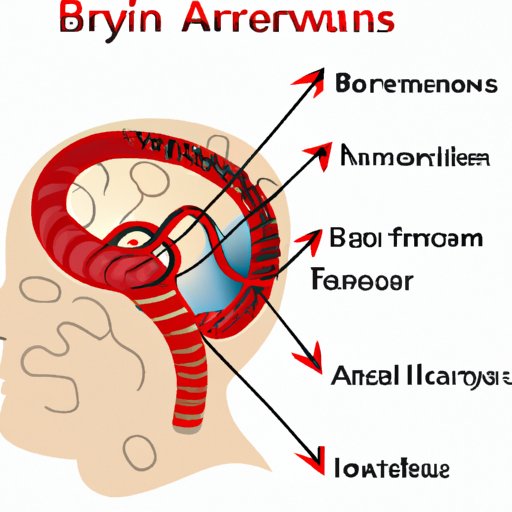
Introduction
A brain aneurysm is a bulge in a blood vessel in the brain. This bulge may leak or rupture, releasing blood into the brain and causing a stroke or even death. Despite being a rare occurrence, brain aneurysms are a serious medical condition that affects thousands of people worldwide. This article aims to provide a comprehensive understanding of brain aneurysms, their risk factors, symptoms, treatment options, prevention, and long-term effects.
Understanding Brain Aneurysms
A brain aneurysm is a bulge or ballooning in a weakened spot in the wall of a brain artery. It can form anywhere in the brain, but the most common location is at the base of the brain where it connects to the spinal cord. Aneurysms are usually asymptomatic, and their rupture can be life-threatening.
The severity of a brain aneurysm depends on its size and location. Small aneurysms, less than 7 mm, are classified as small and do not usually rupture. Large aneurysms, between 7 mm and 15 mm, have a higher risk of rupture, while giant aneurysms, greater than 15 mm, are extremely dangerous and require prompt treatment.
A ruptured brain aneurysm will cause bleeding in the brain and may lead to a stroke, brain damage, or even death. One-third of those who experience a ruptured brain aneurysm survive with long-term neurological deficits.
Risk Factors for Brain Aneurysms
Various risk factors can increase the likelihood of developing a brain aneurysm. Age plays a significant role, as aneurysms are more common in people over 40. Women are at a higher risk, and this can be attributed to hormonal fluctuations in the body.
Family history of brain aneurysms is another risk factor. About 15% of those diagnosed with brain aneurysms have a family history of the condition. Connective tissue disorders such as Ehlers-Danlos and Marfan Syndrome make individuals more susceptible to weakened blood vessel walls, increasing the risk of developing a brain aneurysm.
Smoking, high blood pressure, drug abuse, and excessive alcohol consumption can affect the health of the blood vessels, increasing the likelihood of developing a brain aneurysm. Head injuries, infections, and tumors can also damage the blood vessels in the brain and lead to an aneurysm.
Recognizing Warning Signs and Symptoms
Most brain aneurysms do not cause symptoms, and individuals can live with an aneurysm for years without knowing it’s there. However, when an aneurysm ruptures, it can cause severe symptoms. The following are the most common symptoms:
-
Sudden severe headache that feels like the worst headache of your life
-
Stiff neck
-
Nausea and vomiting
-
Sensitivity to light
-
Sudden blurred or double vision
-
Loss of balance and coordination
-
Seizures
-
Loss of consciousness
If you experience any of these symptoms, seek medical attention immediately. A ruptured brain aneurysm is a medical emergency that requires prompt treatment.
Treatment and Recovery
Once a brain aneurysm is diagnosed through imaging tests such as MRI, CT scans, or angiography, several treatment options are available. The best treatment option depends on the size, location, and severity of the aneurysm. The following are the most common treatment options:
-
Endovascular coiling: A minimally invasive procedure to thread a catheter through an artery and attach a coil to the aneurysm to prevent it from rupturing.
-
Surgical clipping: A procedure that requires surgical intervention to repair the aneurysm by clamping off the base, ultimately stopping the flow of blood to the bulge in the blood vessel.
-
Observation: If the aneurysm is small and not causing symptoms, your doctor may recommend watchful waiting and frequent monitoring through imaging studies.
Recovery after treatment depends on the severity of the aneurysm and the chosen treatment option. Patients who undergo coiling and clip surgery may require rehabilitation and therapy to regain lost motor and cognitive skills.
Real-Life Stories and Case Studies
Learning from others’ experiences battling with a brain aneurysm can offer hope and inspiration to those struggling with the condition.
Leslie is a 52-year-old mother of three who underwent an endovascular procedure to treat her brain aneurysm. The procedure was successful, and she was back to normal within a week. However, she still needed to undergo physical therapy for three months to restore her balance and coordination.
Josh had no prior medical conditions when a brain aneurysm ruptured, causing him to stammer and have a facial droop. He underwent surgical clipping and was on bed rest for six weeks to allow for the healing of a small incision on his scalp.
Prevention and Risk Reduction Strategies
While not all brain aneurysms can be prevented or predicted, some lifestyle changes can reduce the risk of developing the condition:
-
Controlling high blood pressure through medication and lifestyle changes can help maintain healthy blood vessels and reduce the risk of an aneurysm.
-
Quitting smoking and minimizing alcohol consumption remove certain controllable risks.
-
Managing stress and staying active by practicing activities like yoga or jogging can help minimize the risk of developing an aneurysm.
-
Seeking medical attention for head injuries or skull fractures can prevent significant risk.
Long-Term Effects of Brain Aneurysms
Surviving a brain aneurysm can be traumatizing and can have significant long-term effects. Cognitive impairments like memory loss, difficulty focusing, and depression are common side effects of a brain aneurysm. Physical impairments such as difficulty walking, cognitive dysfunction, epilepsy, and visual problems can also be prevalent.
Conclusion
Brain aneurysms are a rare but severe medical condition that can lead to death or long-term disability when left untreated. Understanding risk factors, symptoms, and treatment options is crucial in managing and preventing brain aneurysms. By making the necessary lifestyle changes and seeking prompt medical attention when experiencing symptoms, individuals can reduce the risk of developing a brain aneurysm.





